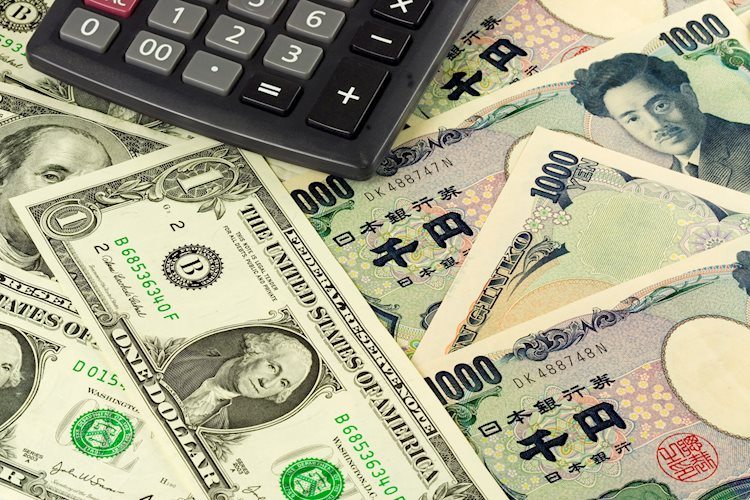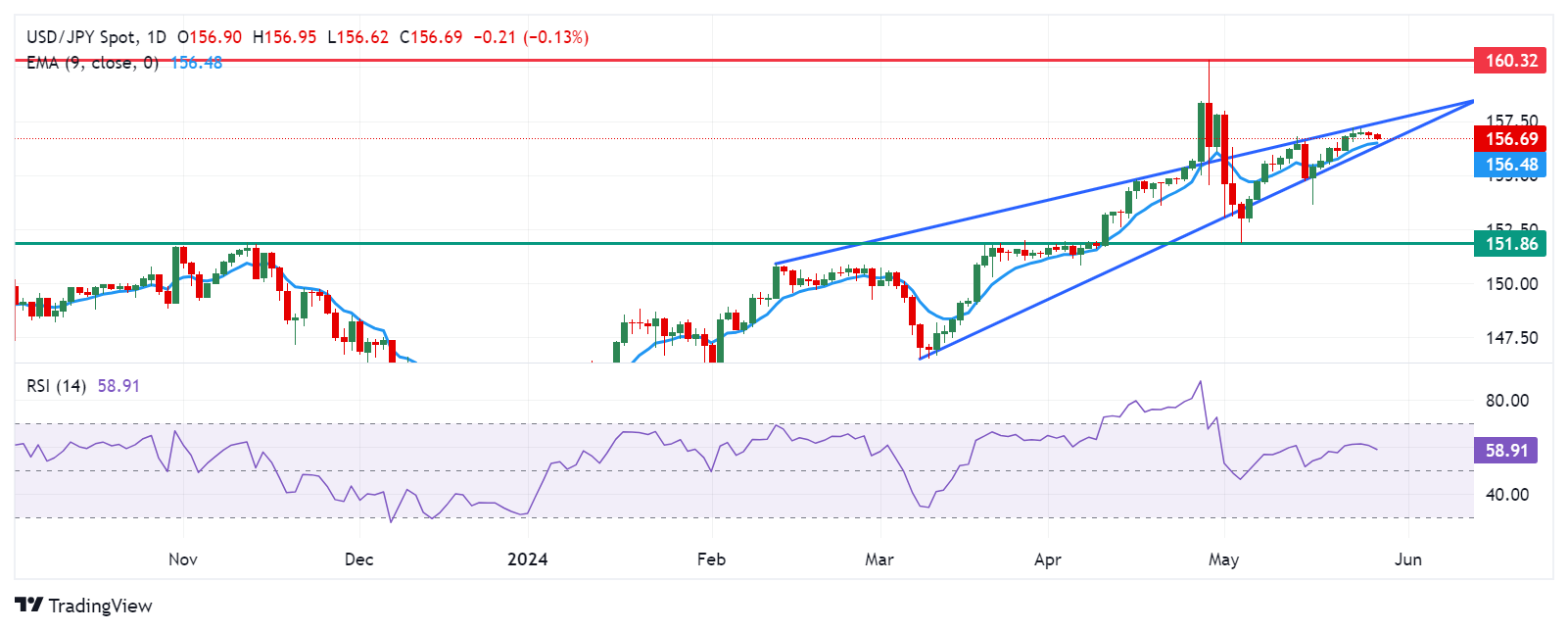- The Japanese Yen struggled after Japan’s Weighted Median Inflation Index showed a slowdown.
- Japan’s Corporate Service Price Index posted a reading of 2.8% YoY in April, marking its fastest increase since March 2015.
- The decline in US Treasury yields put pressure on the US Dollar.
The Japanese Yen (JPY) pares gains after the Bank of Japan (BoJ) published the latest data on Tuesday, indicating that Japan’s Weighted Median Inflation Index, a significant gauge of the country’s trend inflation, increased by 1.1% in April. This growth rate represents a slowdown from the 1.3% increase recorded in March. However, the pair strengthened during the early Asian hours, drawing support from Japan’s Corporate Service Price Index (CSPI). The index posted a year-over-year reading of 2.8% in April, surpassing expectations of 2.3% and marking its fastest rate of increase since March 2015.
The Japanese Yen could have received some support following remarks from Japan Finance Minister Shun’ichi Suzuki on Tuesday, suggesting a potential for verbal intervention. Suzuki emphasized the importance of currencies moving in a stable manner that reflects fundamentals, stating that he is closely monitoring foreign exchange (FX) movements. However, he refrained from commenting on whether Japan has conducted currency intervention.
The US Dollar (USD) continues to lose ground following the decline in the US Treasury yields. Traders are likely to await the Federal Reserve’s preferred measure of inflation, the Personal Consumption Expenditures (PCE) Price Index data, which is due on Friday, to assess future US monetary policy.
Daily Digest Market Movers: Japanese Yen pares gains due to risk aversion
- At the 2024 BOJ-IMES Conference on Tuesday, Cleveland Federal Reserve President Loretta Mester emphasized the importance of FOMC statements providing a detailed description of the current assessment of the economy, its influence on the outlook, and the associated risks. Mester expects that the Fed will consider enhancing communications as part of its next monetary policy framework review.
- Meanwhile, Federal Reserve (Fed) Governor Michelle Bowman highlighted the significance of continuing to reduce the balance sheet size to achieve ample reserves as quickly as possible, particularly while the economy remains robust. Bowman emphasized the importance of communicating any changes to the run-off rate to ensure it is clear that they do not signify a shift in the Fed’s monetary policy stance.
- The Japanese Yen gained strength from the comments of Bank of Japan officials on Monday. BoJ Governor Kazuo Ueda remarked that progress has been made in moving away from zero and raising inflation expectations, but there is a need to re-anchor them, this time at the 2% target.
- Additionally, BoJ Deputy Governor Shinichi Uchida stated that they have reverted to a conventional monetary policy framework to achieve a 2% price stability target through adjustments of the short-term policy rate. Uchida also said that they have successfully navigated past the zero-lower bound.
- In its report on Monday, the Japanese Cabinet Office stated that the government maintained its view on the economy unchanged for the third consecutive month in May. It noted that the Japanese economy continues to recover at a moderate pace, although there are signs of a recent pause in growth.
- UoM 5-year Consumer Inflation Expectations eased slightly to 3.0%, falling below the forecasted 3.1%. Despite the upward revision of the Consumer Sentiment Index to 69.1 from a preliminary reading of 67.4, it still indicated the lowest level in six months. These figures likely bolstered investors’ sentiment regarding potential rate cuts by the Federal Reserve.
- Japan’s National Consumer Price Index (CPI) dropped to 2.5% YoY in April from 2.7% in the previous month, marking the second consecutive month of moderation but still staying above the Bank of Japan’s (BoJ) 2% target. This sustained inflationary trend exerts pressure on the central bank to contemplate policy tightening.
Technical Analysis: USD/JPY maintains its position above 156.50
The USD/JPY pair trades around 156.70 on Tuesday. The daily chart shows a rising wedge pattern, indicating a potential bearish reversal as the pair approaches the wedge’s apex. However, the 14-day Relative Strength Index (RSI) remains slightly above 50, still maintaining a bullish bias.
The pair might test the upper boundary of the rising wedge around 157.45. If it surpasses this level, the next target could be 160.32, representing its highest point in over thirty years.
On the downside, the nine-day Exponential Moving Average (EMA) at 156.48 serves as immediate support, followed by the lower edge of the rising wedge and the psychological level of 156.00. A breach of these levels could exert downward pressure on the USD/JPY pair, potentially leading it towards the throwback support at 151.86.
USD/JPY: Daily Chart
Japanese Yen price today
The table below shows the percentage change of the Japanese Yen (JPY) against listed major currencies today. Japanese Yen was the weakest against the Swiss Franc.
| USD | EUR | GBP | CAD | AUD | JPY | NZD | CHF | |
| USD | -0.10% | 0.06% | -0.01% | -0.04% | 0.05% | -0.12% | -0.27% | |
| EUR | 0.10% | 0.15% | 0.08% | 0.06% | 0.15% | -0.02% | -0.13% | |
| GBP | -0.06% | -0.15% | -0.07% | -0.09% | 0.00% | -0.17% | -0.28% | |
| CAD | 0.01% | -0.08% | 0.06% | -0.03% | 0.07% | -0.11% | -0.21% | |
| AUD | 0.04% | -0.06% | 0.10% | 0.03% | 0.09% | -0.09% | -0.19% | |
| JPY | -0.05% | -0.13% | 0.01% | -0.09% | -0.09% | -0.17% | -0.30% | |
| NZD | 0.12% | 0.03% | 0.17% | 0.11% | 0.08% | 0.18% | -0.13% | |
| CHF | 0.22% | 0.12% | 0.28% | 0.22% | 0.22% | 0.28% | 0.11% |
The heat map shows percentage changes of major currencies against each other. The base currency is picked from the left column, while the quote currency is picked from the top row. For example, if you pick the Euro from the left column and move along the horizontal line to the Japanese Yen, the percentage change displayed in the box will represent EUR (base)/JPY (quote).
Japanese Yen FAQs
The Japanese Yen (JPY) is one of the world’s most traded currencies. Its value is broadly determined by the performance of the Japanese economy, but more specifically by the Bank of Japan’s policy, the differential between Japanese and US bond yields, or risk sentiment among traders, among other factors.
One of the Bank of Japan’s mandates is currency control, so its moves are key for the Yen. The BoJ has directly intervened in currency markets sometimes, generally to lower the value of the Yen, although it refrains from doing it often due to political concerns of its main trading partners. The current BoJ ultra-loose monetary policy, based on massive stimulus to the economy, has caused the Yen to depreciate against its main currency peers. This process has exacerbated more recently due to an increasing policy divergence between the Bank of Japan and other main central banks, which have opted to increase interest rates sharply to fight decades-high levels of inflation.
The BoJ’s stance of sticking to ultra-loose monetary policy has led to a widening policy divergence with other central banks, particularly with the US Federal Reserve. This supports a widening of the differential between the 10-year US and Japanese bonds, which favors the US Dollar against the Japanese Yen.
The Japanese Yen is often seen as a safe-haven investment. This means that in times of market stress, investors are more likely to put their money in the Japanese currency due to its supposed reliability and stability. Turbulent times are likely to strengthen the Yen’s value against other currencies seen as more risky to invest in.

